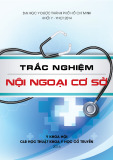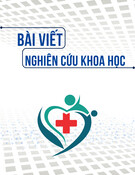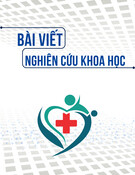
Can Tho Journal of Medicine and Pharmacy 10(7) (2024)
1
THE RATE AND OUTCOMES OF REDUCING RE-HOSPITALIZATIONS
WITH A TREATMENT REGIMEN INCLUDING DAPAGLIFLOZIN IN
HEART FAILURE WITH REDUCED EJECTION FRACTION WITHOUT
DIABETES PATIENTS
Ngo Hoang Toan1,2, Nguyen Tuan Thuan1, Vo Tan Cuong2, Le Dieu Ngan2,
Do Thi Ngoc Diep2, Tran Kim Son1,2*
1Can Tho University of Medicine and Pharmacy
2Can Tho University of Medicine and Pharmacy Hospital
*Corresponding author: tkson@ctump.edu.vn
Received:10/02/2024
Reviewed:28/02/2024
Accepted:25/04/2024
ABSTRACT
Background: Heart failure, a cardiovascular disease with a substantial disease burden,
often leads to frequent hospitalizations for acute episodes. The readmission rate is estimated to be
around 30-50%, resulting in high costs for both pharmacological and non-pharmacological
treatments. Additionally, heart failure is associated with a considerable mortality rate, ranging from
48-57%. Objectives: To describe the rate and outcomes of reducing hospital readmissions for heart
failure in non-diabetes patients and with heart failure featuring reduced ejection fraction, through
the use of Dapagliflozin at Can Tho University of Medicine and Pharmacy Hospital. Materials and
methods: A cross-sectional descriptive study was conducted 44 non-diabetes and heart failure with
reduced ejection fraction patients who were examined and treated at Can Tho University of
Medicine and Pharmacy Hospital. Results: The average age of patients was 67.3 ± 13, with male
patients representing 65.9%. Shortness of breath was the most common symptom (77.3%). Other
frequently observed symptoms included distended neck veins, peripheral edema, and rales in the
lungs. The average ejection fraction was 36.65 ± 8.16%. In terms of functional classification, NYHA
III represents the highest proportion at 54.5%. The median NT-proBNP concentration was 8757
pg/mL (ranging from a minimum of 604 pg/mL to a maximum of 35.000 pg/mL). The observed
improvement rate in NYHA classification after treatment was 13.6%. The rate of rehospitalization
for heart failure before treatment was 27.3%, decreasing to 11.4% after treatment (p=0.118 but the
analysis suggests that there were no independent risk factors contributing to rehospitalization for
heart failure in patients with reduced ejection fraction without diabetes.Conclusions: Dyspnea was
the most common symptom in patients with heart failure with reduced ejection fraction and non-
diabetes. The rate of rehospitalization for heart failure after 12 weeks of Dapagliflozin treatment
was lower than before treatment, but this difference was not statistically significant.
Keywords: Heart failure with reduced ejection fraction, Diabetes, Dapagliflozin.
I. INTRODUCTION
Heart failure represents a global health challenge, with its incidence steadily rising
in both developed and developing nations [1]. Among the various subtypes of heart failure,
heart failure with reduced ejection fraction constitutes 45-70% of cases [2]. Despite active
treatment with numerous medications, heart failure remains a cardiovascular disease with a
substantial disease burden. Patients frequently experience hospitalizations due to acute heart
failure, with a readmission rate of approximately 30-50% [3]. During periods of
decompensation, patients face work incapacity, and the associated care costs are high,
encompassing both pharmacological and non-pharmacological treatments. Additionally,
there is a notable mortality rate ranging from 48-57% [4].

Can Tho Journal of Medicine and Pharmacy 10(7) (2024)
2
Dapagliflozin, a novel medication, has demonstrated efficacy in heart failure
treatment. Numerous global studies have affirmed the drug's effectiveness in reducing the
rates of heart failure rehospitalization and cardiovascular-related deaths, irrespective of the
presence of diabetes mellitus [5]. However, in clinical practice, disparities persist in the
recommended and actual treatment of patients with heart failure with reduced ejection
fraction, and the effectiveness of Dapagliflozin in Vietnamese subjects is not well-
documented. Therefore, the objective of describing the rate and outcomes of reducing
hospital readmissions for heart failure in patients with heart failure featuring reduced
ejection fraction without diabetes using Dapagliflozin.
II. MATERIALS AND METHODS
2.1. Research subjects: Patients diagnosed with heart failure and reduced ejection
fraction and non-diabetes sought examination and treatment at Can Tho University of
Medicine and Pharmacy Hospital from May 2023 to December 2023.
Sample selection criteria
Patients satisfy all of the following criteria:
Age: Participants must be aged 18 years or older.
Heart failure diagnosis: Patients diagnosed with heart failure and reduced ejection
fraction according to VNHA 2022 standards for more than 3 months before the start of
participation [6].
Diabetes status: Patients must not meet the criteria for diagnosing diabetes according
to ADA 2021 [7].
Medical Therapy: Patients should be actively using reduced ejection fraction heart
failure medical therapy according to VNHA 2022, which includes a full range of drugs such
as ACE inhibitors/ARNI, beta blockers, and aldosterone antagonists [6].
Exclusion Criteria
Patients meeting any of the following criteria will be excluded from the study:
Current use of Dapagliflozin: Individuals currently using dapagliflozin to treat any
other condition at the time of study participation.
Symptomatic hypotension: Participants experiencing symptomatic hypotension or
having a systolic blood pressure <95 mmHg in two consecutive measurements.
Reduced kidney function: Individuals with an estimated glomerular filtration rate
(eGFR) <30 ml/min/1.73 m².
2.2. Research Methods
Study design: A cross-sectional descriptive study.
The sampling method: patients in this study is convenience sampling.
2.3. Data collection
General characteristics of patients with heart failure and reduced ejection fraction:
this includes age, gender, and medical history.
Clinical and paraclinical characteristics in patients with heart failure and reduced
ejection fraction.
Rate and outcomes of reduced rehospitalization for heart failure with Dapagliflozin
treatment: The treatment regimen for study subjects is based on VNHA 2022 heart failure
treatment recommendations [6]. Drug classes, indications, and dosages adhere to these
recommendations. Dapagliflozin, marketed as Forxiga, with a content of 10 mg, was
administered at a dose of 1 tablet/day. The pre-treatment readmission rate was assessed by

Can Tho Journal of Medicine and Pharmacy 10(7) (2024)
3
reviewing medical records or conducting interviews covering the 12 weeks before
admission. Readmission for heart failure was treated as a qualitative variable, recorded
when the patient exhibits symptoms or signs of new or worsening heart failure. This
information was gathered through interviews with the patient, their relatives, or by
reviewing the patient's discharge papers. Improvement in NYHA (New York Heart
Association) class was also recorded as a qualitative variable, noting instances where the
patient decreases at least one level on the NYHA scale.
2.4. Statistical Analysis: The data were processed and analyzed using SPSS 22.0
software. Qualitative variables are presented as frequencies and percentages, while
quantitative variables are reported as mean ± standard deviation for normally distributed
variables or as median, maximum value, and minimum value for variables with a non-
normal distribution. The McNemar test was utilized to assess differences between two
related groups when the measured variable in the paired t-test was binary.
2.5. Ethical Approval: The study was conducted in accordance with the Declaration
of Helsinki and approved by the Ethics Committee of Can Tho University of Medicine and
Pharmacy (protocol code 23. 035.GV/PCT-HĐĐĐ in 2023).
III. RESULTS
3.1. Baseline Subject Characteristics
Table 1. Baseline characteristics of the study population
Parameter
n
%
Male
29
65.9%
Age group
< 60
12
27.3%
≥ 60
32
72.7%
Mean ± SD
67.3 ± 13
Medical history
Hypertension
32
72.7%
Coronary artery disease
19
43.2%
Heart valve disease
11
25,0%
Cardiomyopathy
8
18.2%
Arrhythmias
6
13.6%
A higher proportion of patients in the study are male, constituting 63.3%, while
female patients make up the remaining percentage. Among the patients, those aged 60 years
and older represent the largest subgroup, accounting for 72.7% of the total. The average age
of the patients is 67.3, ranging from the youngest at 40 to the oldest at 93. Notably, a history
of hypertension is prevalent, representing the highest rate at 72.7% (Table 1).
Table 2. Clinical and paraclinical characteristics of research subjects
Symptoms at admission
n
%
Shortness of breath
34
77.3
Dry cough
13
29.5
Weakness and fatigue
17
38.6
Peripheral edema
28
63.6
Enlarged liver
5
11.4
Distended neck veins
30
68.2

Can Tho Journal of Medicine and Pharmacy 10(7) (2024)
4
Symptoms at admission
n
%
Lung rales
25
56.8
T3
1
2.3
NYHA Classification
II
20
45.5%
III
24
54.5%
Paraclinical
Ejection fraction (EF) (%)
EF: 31-40%
9
20.5%
EF: ≤30%
35
79.5%
Mean± SD
36.65 ± 8.16
NT- pro BNP (pg/mL)
Median
8757
Min
604
Max
35000
Heart failure patients with reduced ejection fraction and non-diabetes, upon hospital
admission, commonly presented with symptoms such as shortness of breath, dry cough, and
weakness. Notably, Shortness of breath as the most prevalent symptom, affecting 77.3% of
patients. Physical manifestations include distended neck veins observed in 68.2% of
patients, peripheral edema in 63.6% of patients, and pulmonary rales in 56.8% of patients.
Additional physical symptoms, such as hepatomegaly, were noted in 11.4% of patients, and
a S3 heart sound was present in 2.3% of patients. Ejection fraction analysis revealed that
79.5% of patients had severely reduced EF, while 20.5% had moderately reduced EF. The
mean EF was 36.65 ± 8.16. In terms of functional classification, NYHA III represents the
highest proportion at 54.5%. The median NT-proBNP concentration was 8757 pg/mL
(ranging from a minimum of 604 pg/mL to a maximum of 35.000 pg/mL) (Table 2).
3.2. The hospital readmission rate and outcomes of reducing readmissions with
Dapagliflozin.
Figure 1. The hospital readmission rate before and after treatment with the regimen
including Dapagliflozin
27.3
11.4
Figureospital re-admission
Before After

Can Tho Journal of Medicine and Pharmacy 10(7) (2024)
5
The observed readmission rate for heart failure following Dapagliflozin treatment
was 11.4% (Figure 1).
Table 3. The NYHA and a reduction in the hospital readmission rate after 12 weeks of
treatment.
Characteristics
Treatment
p
Before
After
n
%
n
%
Hospital readmission
Yes
12
27.3
5
11.4
0.118
No
32
72.7
39
88.6
NYHA
II
20
45.5
25
56.8
0.063
III
23
52.3
19
43.2
NYHA Improvement
Yes
-
6
13.6
No
38
86.4
The readmission rates for heart failure before and after Dapagliflozin treatment were
27.3% and 11.4%, respectively. Notably, this difference did not reach statistical significance
(p = 0.118). The observed improvement rate in NYHA classification after treatment was
13.6% (Table 3).
Table 4. Multivariable logistic regression between readmission for heart failure and
independent risk variables.
Risk factors
OR
95%CI
p
Age≥ 60
5.4
0.7
42
0.1
Male
2.5
0.4
15.2
0.32
Hypertension
8.4
0.9
77.2
0.06
Coronary artery disease
10.1
0.5
205.9
0.13
Heart valve disease
0.4
0.01
18
0.67
Cardiomyopathy
0.3
0.01
8.1
0.48
Arrhythmias
1.1
0.3
31.1
0.9
NYHA III
1.6
0.3
9.1
0.57
EF ≤ 30%
5.5
0.4
70.1
0.19
NT-proBNP >20000 (pg/mL)
2.4
0.24
25.9
0.45
There were no independent risk factors contributing to rehospitalization for heart
failure in patients with reduced ejection fraction non-diabetes (Table 4).
IV. DISCUSSION
Through our research, we observed that the percentage of patients in the age group
≥ 60 was higher than that in the age group < 60, constituting 72.7% and 27.3%, respectively.
The average age of patients with diverse heart failure and reduced ejection fraction and non-
diabetes was 67.3 ± 13. This finding aligns with the study conducted by Nguyen Hai Nguyen
(2014), where the age group ≥ 60 accounted for 75%, with an average age of 69.3 ± 16.1
[8]. In our study, the proportion of male patients was 65.9%, resembling the gender
distribution found in Nguyen Duy Toan's study in 2018, where the proportions were 72.0%
for men and 28% for women [9]. Middle-aged and elderly male often exhibit multiple risk
factors, including smoking, alcohol consumption, and high protein intake. These factors
collectively contributed significantly to the development of heart disease and impact
treatment outcomes. Clinically, dyspnea was the predominant symptom in most patients,











![Tài liệu Triệu chứng học nội khoa [mới nhất]](https://cdn.tailieu.vn/images/document/thumbnail/2025/20251204/oanhlahet@gmail.com/135x160/5231764900514.jpg)


![Bài giảng Vi sinh vật: Đại cương về miễn dịch và ứng dụng [chuẩn nhất]](https://cdn.tailieu.vn/images/document/thumbnail/2025/20251124/royalnguyen223@gmail.com/135x160/49791764038504.jpg)











